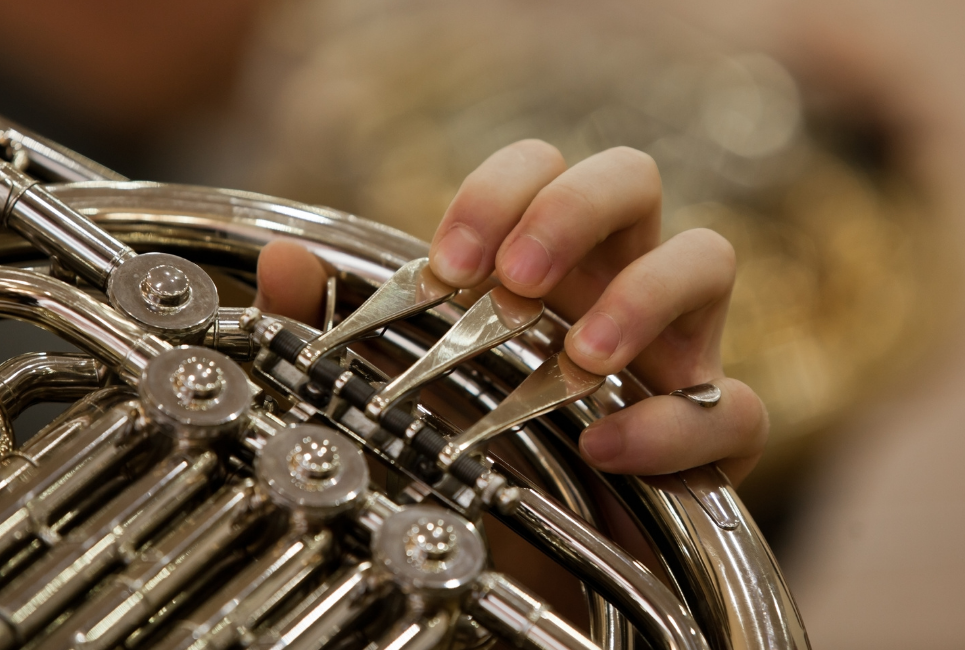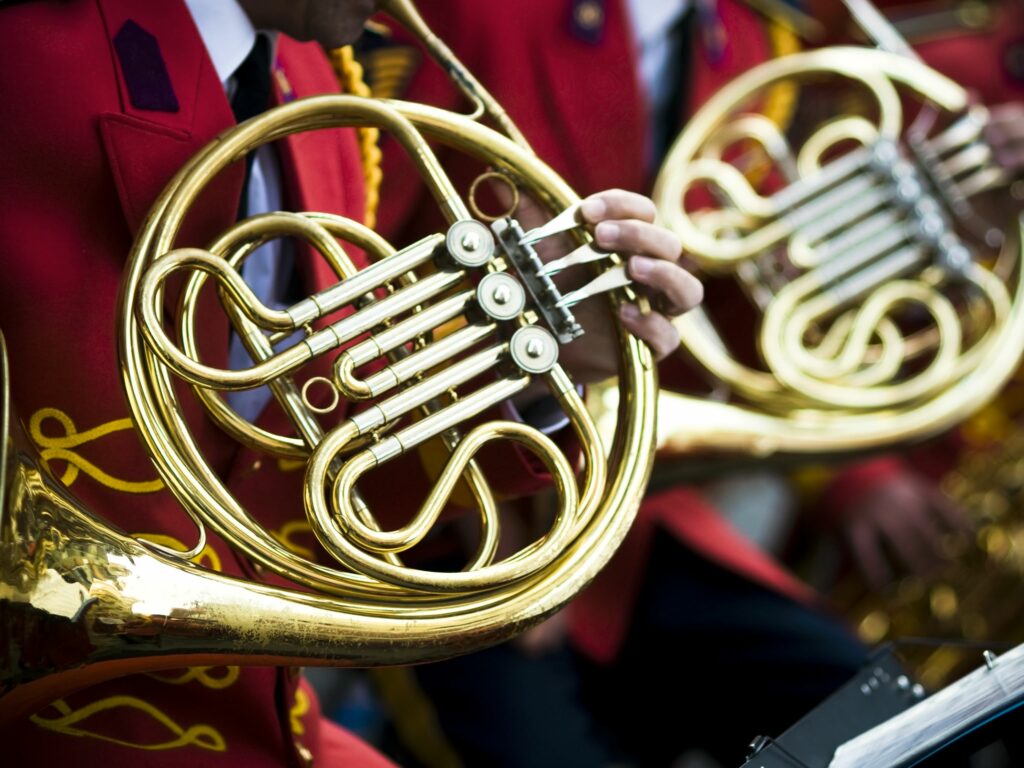- Top Trumpet Embouchure Techniques: Options for Beginners Through Professionals - October 12, 2022
- Is the Trumpet Hard to Learn? - September 30, 2022
- Best Leblanc Clarinet Models Guide: From Soprano to Contrabass - September 5, 2022
Don’t let the curvy design of the French horn fool you. It may have a lot of tubing and twists, but a French horn fingering chart guide is pretty simple. With only three or four valves, you don’t need to memorize dozens of fingerings. But you do need to know which fingerings can play which notes.
How French Horn Fingerings Work
Like other brass instruments, French horns have valves that you press to change the length of the tubing, which helps change the pitch. All horns have at least three valves, but double horns have four. The fourth valve lets you access a second “side” of the instrument, and it gives you more fingerings to use. Plus, it can make playing in the higher register a little easier.
However, while you use your right hand to press valves on instruments like the trumpet or cornet, you use your left hand when playing the French horn. Whether the horn is your first brass instrument or not, knowing how the fingerings work is crucial. Then, you can learn how to play the horn efficiently and correctly.
How to Read a French Horn Fingering Chart
Most French horn fingering charts will include the notes within the treble clef. Above the note, it will tell you the note name, such as F. Below the note, you will see a line of three circles, or you might see two lines of three circles each.
The first line only uses three valves, so you can use those fingerings on any horn. However, the second line requires the fourth valve that you trigger with your left thumb. Each circle represents one of the three valves that you trigger with your first, second, or third finger. If the circle is open, you don’t press that valve. When the circle is black, you will press that valve.
If you read the second line of fingerings, you may see the letter “T” to the left of the circles. That means you’ll press the thumb valve, but you’ll leave it up when the letter isn’t there. You might also see the valves listed as 1, 2, and 3. That’s a great way to describe the fingerings without using a visual chart.
Single vs Double Horn Fingerings
You can play the most basic French horn fingerings on a single or double horn. However, a double horn has two sides of tubing, one of which is in the key of F and the other in Bb. The basic single horn is in F, so you can use the same fingerings on a double horn when you don’t trigger the thumb. If you switch to the Bb side, you’ll need to use different fingerings.
Even if you start on a double horn, you should learn the fingerings for the single horn. Then, you can know more fingerings, and you can use those fingerings with the Bb fingerings. When playing up above the treble clef, you’ll usually want to switch to the Bb side. But some notes can sound good on that side in the lower register.
By learning both systems, you can select the fingerings that work the best for you and your horn. Then, you can enjoy playing, and you can get the sound you want.
First Octave Fingerings
The first octave of the French horn goes from the written F below middle C up to the E just above middle C. To play the lowest note on the horn, you’ll want to press the first valve.
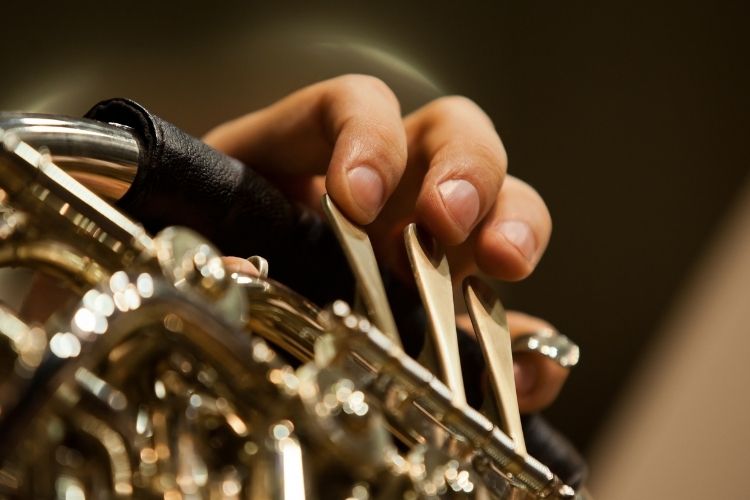
If you have a double horn, you can also press the thumb valve and leave the other three up. When using the standard fingering, you can also play the D in the first octave. Some notes stay the same whether you have a single or double horn, including G#/Ab, A, A#/Bb, B, and C. valves.
Second Octave Fingerings
Moving to the next octave, the standard fingerings somewhat mirror those in the first octave. The one exception is the second octave D, which uses no valves, while the first octave D uses the first valve. Other notes, like F and G#/Ab through C, either add or subtract the thumb on a double horn. When you first learn the second octave, you’ll need to focus on your embouchure.
That way, you can use your air to play the correct pitch and keep from getting the lower notes. It may take a while to get used to the switch, but you can practice playing the different octaves after another to learn how the change feels.
Top Notes
The horn doesn’t usually play a full third octave, but it can play from the F at the top of the treble clef to the C above that. As with the other octaves, the notes F, G#/Ab, A, A#/Bb, B, and C all share the fingerings with their lower counterparts.
The standard fingerings for F#/Gb and G are the same as those notes in the first octave. For all of the notes in this range, you can add the thumb valve and not move any of your other fingerings. The Bb side is shorter than the F side, so it can provide less resistance in the upper range of the horn. Then, you don’t have to work as hard to get those notes to come out.
How to Learn French Horn Fingerings
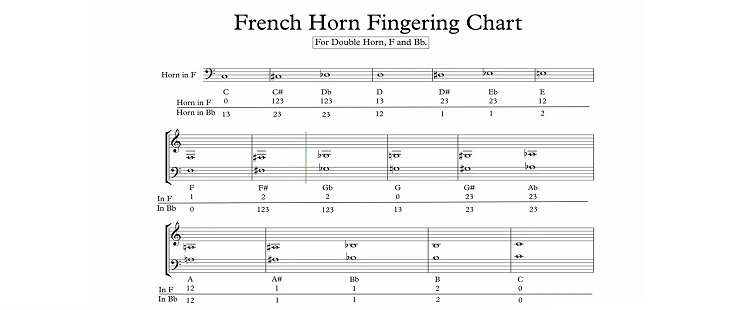
Now that you understand how to read the French horn fingering chart and how the fingerings work, it’s time to learn and practice playing the different notes. Fortunately, there are only 16 possible fingerings for the entire instrument.
But there’s more to playing the notes than pressing the correct valves. Here are a few tips to help you learn the fingerings of the French horn.
Get a Fingering Chart
You can find a free fingering chart online, or you can buy one that you keep on your music stand. That way, you’ll be able to quickly reference the chart when learning a new note. Add fingering charts may even have fingerings for notes higher or lower than other charts. Lower notes, like pedal tones, can be hard to achieve, but they’re worth learning.
No matter which fingering chart you get, keep it in good condition. Then, you can use it whenever you want to learn a different fingering, even for a note you already know.
Due to the enormous success of our Instrumental Fingering Posters we thought it would be extremely helpful to create a smaller 9 x 12 version that would fit comfortably into every method book which any beginning student has been assigned.
French Horn Music Practice
One of the best ways to learn French horn fingerings is to play music that uses the fingerings. Of course, you can practice individual notes, but you’ll hardly play one note in the context of a piece.
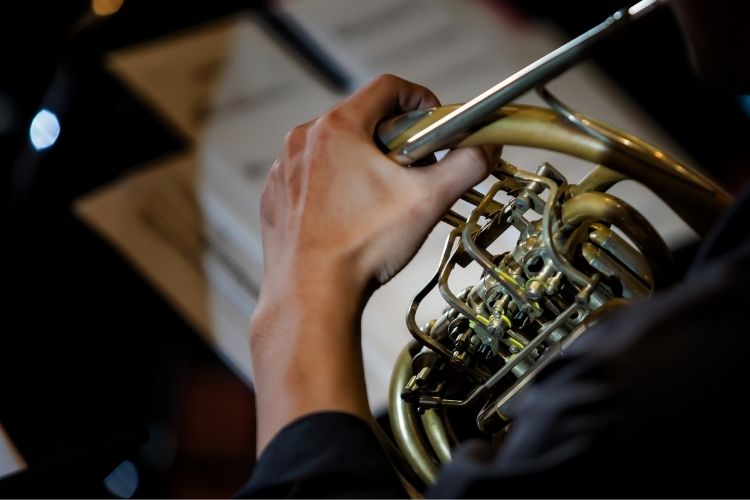
Get a French horn book that can both teach you new notes and get you playing melodies quickly. The songs don’t need to be complex, but they should reinforce the pitches as you learn them.
As you practice the French horn, you can play these melodies to make your practice sessions more exciting. A good book will also slowly get more difficult so that you always have a bit of a challenge so that you don’t get bored.
One of the most widely used series of methods for individual or instrument class instruction. Using a very well-rounded approach including scales, arpeggios, technical studies, studies for musicianship, articulation studies, solos, duets, and studies devoted to the special needs of each instrument, this series provides a fantastic wealth of material for all student musicians.
Work on Your Embouchure
Maybe you’ve memorized which valves to press for certain notes, but you still aren’t getting the correct pitch. You may need to practice adjusting your embouchure. For example, the written notes G3, C4, E4, G4, C5, D5, E5, G5, and C6 all share the same fingering. That means your lips and air need to be slightly different for each of those pitches.
And as you work to the top of the horn’s register, the notes can get closer together. Take time each day to work on your embouchure and practice switching between pitches with the same fingering until you can switch easily.
Use the Tuner
As you work on your embouchure while changing notes, put a tuner in front of you. Then, you can figure out what each pitch sounds like, and you can make sure you hit the pitch you want when practicing. There are plenty of tuner apps you can download to your smartphone. But you may also want to get a physical tuner to use when you don’t have a phone available.
The tuner can also help you tune your instrument before playing. And you can continue to use it even after you get the basics of each note so that you can keep refining your tone.
The best-selling Kong tm series, which lets you use a tuner and metronome simultaneously, has been revamped. The TM-60 is the newest model and features a larger display that can show the tuner and metronome simultaneously.
Take Some Private Lessons
Private lessons aren’t the right choice for everyone, but they can be super helpful as a beginner. You can work with a professional French horn player. They can give you strategies on how to improve your playing, and they may be able to tell you why you can’t get a certain note to come out. Plus, they can give you more music to play to help put your new skills into practice.

Even one private lesson can be enough. That way, you won’t risk developing bad habits that could hurt you and cause you to have to stop playing.
FAQs
Answer: While most horn music is between the F below middle C and the C above the treble clef, the instrument has a bigger range. A professional may be able to play as low as two octaves below middle C. In some cases, you may be able to play above the top C on the horn as well. But that takes practice, so you don’t need to worry about those notes as a beginner.
Answer: The most common French horn is in the key of F, and that applies to single and double horns. That means the pitch will sound a fifth higher than written, so keep that in mind when using a tuner. Double horns will have a side in the key of Bb, but that doesn’t change the music you read. Whether you use the thumb valve or not, you’ll read music in the same key.
Answer: Because there are only three or four valves, there aren’t a ton of combinations for fingerings. For example, a single horn only has eight possible fingerings. But since there are way more than eight notes on a French horn, some have to share the same fingering. Fortunately, your fingers aren’t the only way to change the pitch you play on the instrument.
Answer: When looking at a French horn fingering chart, you may think a single horn is bad. It doesn’t have many possibilities as a double horn. However, double horns are more expensive and much heavier. If you want to save money and weight, a single horn is an excellent choice when you start to learn to play the French horn.
Answer: The French horn’s design makes the left hand the better choice for pressing the valves. Horns have rotary valves, which are quite different from the piston valves on trumpets or cornets. A horn player also usually uses their right hand to support the bell. They’ll also put their right hand in the bell to help mute the sound, so the left hand is the ideal choice for triggering the valves.
Answer: The French horn has a different set of fingerings Compared to other brass instruments. Whether you’re learning the French horn as your first brass instrument or not, you should learn the fingerings from scratch. It can be hard to ignore other fingering systems. But doing so will allow you to play the correct notes from the start.
Final Note on the French Horn Fingering Chart Guide
Looking at a French horn fingering chart guide is crucial for beginners and professionals alike. Whether you’re looking to learn the first few notes or expand your range, you need to use the right fingerings.
That way, you’ll be able to play pitches from low to high. Just don’t forget to also work on your embouchure because that’s just as important as your fingers.

